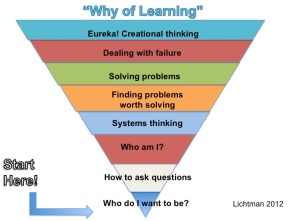Today I had two comments from deep in my archive (all of a year ago) on my post about Flipping or Doubling Bloom’s Taxonomy, including this from Bree Berman, an instructional coach at Flint Hill School:
Your focus on the “why” as primary made me think about how teachers view their students’ motivations. Frequently I hear, “Kids only care about grades! We need to help them focus on the learning” which I believe is true, but hard to do when the content to be covered is not of particular interest to a student. I don’t know any teachers who don’t put every effort into making their material interesting, but still, students are (on the whole) being asked to learn certain ideas at certain times, regardless of their natural curiosities.
I loved re-imagining Bloom as I did in The Falconer by flipping the pyramid to start with questions, not content and work forward from there. So here is the link to that post and the flipped triangle, and thanks again to Shelley Wright for starting my thinking last year.
- Who do I want to be? If we don’t have a personal stake in the outcome, a model to follow, how do we get engaged in the process? We have to help students derive their own model for why they should care about what they need to learn in school.
- How to ask questions. Students need to develop their own questions. None of us will put in a huge effort to pursue an end that does provide a challenge to our interests.
- Who am I? What is my worldview and what is my relationship to the world around me? If we don’t know that, it is hard to place systems thinking in a manageable context.
- Systems thinking. Learning to understand and analyze complex relationships. Without these skills, finding and solving problems is just guesswork.
- Problem finding. Students need to find problems that they really want to solve. It is up to teachers to create environments of dissonance in which students will be eager to find problems.
- Problem solving. Synthesizing multiple inputs to solve those problems that we really want to solve. Without all that precedes this step, none of us have a personal stake in problem solving.
- Dealing with failure because problem solving is hard and inexact, and we learn more from failure than we do from success.
- Creational thinking. Discovering those nuggets of elegant new knowledge once you have put in the hard work that makes it all worthwhile.





[…] Today I had two comments from deep in my archive (all of a year ago) on my post about Flipping or Doubling Bloom's Taxonomy, including this from Bree Berman, an instructional coach at Flint Hill Sc… […]